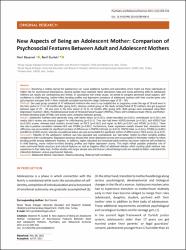| dc.contributor.author | Beşenek, Ali Mert | |
| dc.contributor.author | Gürlek, Beril | |
| dc.date.accessioned | 2022-09-27T07:15:26Z | |
| dc.date.available | 2022-09-27T07:15:26Z | |
| dc.date.issued | 2021 | en_US |
| dc.identifier.citation | Besenek, A.M. & Gürlek, B. (2021). New Aspects of Being an Adolescent Mother: Comparison of Psychosocial Features Between Adult and Adolescent Mothers. Psychiatry and Behavioral Sciences, 11(3), 209-218. http://doi.org/10.5455/PBS.20210528045819 | en_US |
| dc.identifier.issn | 2636-834X | |
| dc.identifier.uri | http://doi.org/10.5455/PBS.20210528045819 | |
| dc.identifier.uri | https://hdl.handle.net/11436/6554 | |
| dc.description.abstract | Objective: Becoming a mother during the adolescence can cause additional burdens and adversities which might put these individuals at higher risk for psychosocial disturbances. Several studies have reported higher depression rates and worse parenting skills for adolescent mothers but results are contradicting and limited. In accordance with these issues, we aimed to compare perceived social support, selfconfidence in child-bearing, mother-infant bonding profiles and depressive symptoms of adolescent mothers with their counter-parts who got pregnant and gave birth in their medically accepted reproductive stage (between ages of 25 - 30).
Methods: Our case group consisted of 47 adolescent mothers who were to our hospital due to pregnancy under the age of 18 and were in the time period of 12 to 18 months after giving birth; whereas control group of the study included total of 53 mothers who got pregnant between ages of 25 - 30 and were in the time period of 12 to 18 months after giving birth. Both groups were evaluated using Beck Depression Inventory (BDI), Multidimensional Scale of Perceived Social Support (MSPSS), Pharis Self-Confidence Scale (PSCS) and Mother to-Infant Bonding Scale (MTIBS) and scores were compared between groups.
Results: Adolescent mothers were generally living with family elders (p=0.001), under-educated (p<0.001), unemployed (p<0.001) and mostly didn't receive any physical support for child-bearing (p=0.011). They also had lower MSPSS-Intimate (p<0.001) and MSPSS-Total (p<0.001) scores; whereas adult mothers scored lower on PSCS (p=0.001) and higher on BDI (p<0.001) and MTIBS (p<0.001). There was also a positive correlation between BDI and MTIBS (p<0.001). Furthermore, linear regression models showed that, education level difference was accountable for significant portions of differences in MSPSS-Intimate (p=0.013), MSPSS-Total (p=0.016), MTIBS (p=0.002) and BDI (p=0.003) scores; whereas occupational status was only accountable for significant portion of differences in PSCS scores (p=0.019).
Conclusion: Majority of the adolescent mothers was less educated and unemployed; but had better mother-to-infant bonding profiles compared to their counterparts. Regression analyses showed that lower depression scores were accountable for this better mother-to-infant bonding profile among adolescent mothers. In addition, higher educated and employed adult mothers had lower maternal self-confidence in child bearing, worse mother-to-infant bonding profiles and higher depression scores. This might reflect possible protective role of more communal family structure and cultural features as well as negative effect of additional distress which working adult mothers may experience in their daily lives. Further studies with larger sample size and diverse cultural backgrounds are needed to better understand the interaction between various psychosocial features. | en_US |
| dc.language.iso | eng | en_US |
| dc.publisher | Yerküre Tanıtım & Yayıncılık Hizmetleri | en_US |
| dc.rights | info:eu-repo/semantics/openAccess | en_US |
| dc.subject | Adolescent mother | en_US |
| dc.subject | Depression | en_US |
| dc.subject | Maternal bonding | en_US |
| dc.subject | Maternal self-confidence | en_US |
| dc.title | New aspects of being an adolescent mother: Comparison of psychosocial features between adult and adolescent mothers | en_US |
| dc.type | article | en_US |
| dc.contributor.department | RTEÜ, Tıp Fakültesi, Dahili Tıp Bilimleri Bölümü | en_US |
| dc.contributor.institutionauthor | Beşenek, Ali Mert | |
| dc.contributor.institutionauthor | Gürlek, Beril | |
| dc.identifier.doi | 10.5455/PBS.20210528045819 | en_US |
| dc.identifier.volume | 11 | en_US |
| dc.identifier.issue | 3 | en_US |
| dc.identifier.startpage | 209 | en_US |
| dc.identifier.endpage | 218 | en_US |
| dc.relation.journal | Psychiatry and Behavioral Sciences | en_US |
| dc.relation.publicationcategory | Makale - Ulusal Hakemli Dergi - Kurum Öğretim Elemanı | en_US |


















